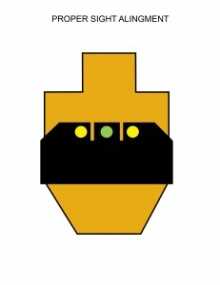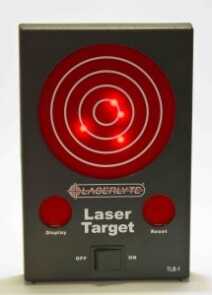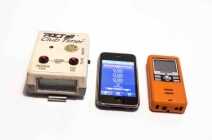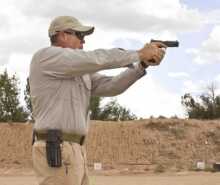By Richard Mann
You do not have to make your gun go bang to improve your shooting. This is good news because often you cannot go to the range and sometimes you just cannot afford ammo. Dry practice, practice with your firearm without ammunition, is a viable training tool and can help you master many aspects of the defensive handgun.
Dry practice can be done almost anywhere, but there are some rules. The first four rules are the same four rules that should be followed anytime you are handling a firearm.
- All guns are always loaded.
- Never let the muzzle cover anything you are not willing to destroy.
- Keep you finger off the trigger until your sights are on the target.
- Always be sure of your target.
In addition to these four rules, you should also only conduct dry practice in an area from which all ammunition has been removed. This cannot be stressed enough. Establish a routine for dry practice. Place all your ammunition in a container, triple check your firearm and remove the container of ammunition to another location.

The most common way that dry practice is used is to improve a shooter’s ability to keep the sights aligned while pulling the trigger.
Sight Alignment and Trigger Control
The most common use of dry practice is to improve your sight alignment and trigger control. Working with a handgun that will not recoil or make a loud noise when you pull the trigger allows you to concentrate fully on keeping the sights aligned while you press the trigger. The goal, obviously, is to complete the trigger stoke without disturbing your sight picture or sight alignment.
The process is simple. Pointing the handgun at a target that is safe (See rule 2 and 4), align the sights and press the trigger while watching for deviations in your sight picture and alignment. I have found a laser like Crimson Trace laser grips can be a great tool when doing this because even the slightest movement of the laser is easy to detect. Adjust the laser so that it appears on the target about two inches above your front sight. That makes it easy to see while you’re still using your sights.
Another option, and one that I have used a good deal when training new handgun shooters, is the LaserLyte Target. This small target reacts to laser beams emitted from the LaserLyte laser pistol cartridge and records the hit for display after a string of dry practice shots. As detailed in my book, Handgun Training for Personal Protection, with only about five minutes of practice per week with these training tools, I have seen more than a 20% reduction in group size.
The key to beneficial dry practice when working to improve your sight alignment and trigger control is to not overdo it. Between five and fifteen minutes of practice per day is plenty. Take your time with every shot and do not rush the process.

By using the LaserLyte laser target and laser cartridge, you can actually see the results of your dry practice on target.
Weapon Presentation
Weapon presentation or the draw is another skill you can practice without ammunition. From a defensive handgun standpoint, getting your handgun out quickly can make the difference between life and death. However, not only do you need to get it out of the holster quickly, you need to get it on target quickly. The key to speed is smoothness, and smoothness comes with repetition. Start slowly and proceed with speed only after you have perfected the presentation stroke.
A Crimson Trace laser grip can be beneficial here too. When you are drawing a handgun, you should establish a good shooting grip before the handgun ever leaves the holster. If you do this and your handgun has a Crimson Trace laser grip, the laser will come on and will provide you with exact knowledge of where your muzzle is pointing all the way through the draw stroke.

As you thrust the handgun towards the target, watch the laser to make sure you keep the handgun pointed at the target.

As you obtain a two-hand grip on the handgun, the laser should continue to verify that it is pointed at the target.

When you rotate your handgun towards the target, the laser should verify that the muzzle is pointing at the target.

When working dry practice to perfect weapon presentation, a laser grip can help to insure you obtain a firing grip while the handgun is in the holster.
What we are looking for is efficiency of motion. The handgun should come up and out of the holster, and then it should be rotated toward the target before it is thrust forward to the target. After the rotation, you should see the laser on the target until your arms are fully extended into whatever shooting position you use. Again, work slowly and deliberately. Only 10 to 15 minutes of practice each day is all that is needed, and in a week you will have greatly improved your draw stroke.
Reloading
You can also practice reloading your handgun without live ammunition. Dummy rounds are nice to have for these drills and add realism. You can practice all sorts of reloads such as a speed reload, a tactical reload, a slide lock reload and even a one-hand reload, and you will only need a handful of dummy round to do this.
One of the best ways to evaluate your reload practice, particularly the speed reload and slide lock reload, is to use a shot timer. Set the timer to beep at a par time, say about four seconds. When you here the beep to start, begin you reload sequence and try to complete the sequence before the par time beep. As you improve, reduce the par time.
Just as with sight alignment and trigger control and weapon presentation training, start reload training slowly. Smoothness breeds speed, and until you master

Dummy rounds will function through a semi-auto pistol just like live rounds but without the bang. Dummy rounds are great for dry practice.
the mechanics of reloading you cannot increase your speed.
As you progress in skill, you can combine all three aspects – sight alignment and trigger control, weapon presentation and reloading – into one dry practice drill. Using a the LaserLyte target and laser cartridge, present your handgun to the target, align the sights and pull the trigger, and then conduct a speed reload while using a shot timer to gauge your speed. However, regardless of the drills you conduct, do not overlook the safety rules.
As a final thought, dry practice is not just for times when you cannot go to the range. It’s not a bad idea to start and end every live fire range session with dry practice. In fact, it should be part of most live fire sessions because it adds to your training experience. Because dry practice allows you to completely concentrate on the mechanics of what you are doing, you should even use it, intermittingly, while conducting live fire exercises.

.: A shot timer is an affordable tool when dry practicing reloads. They even make shot timer apps for smart phones.







I use a Laserlyte laser trainer cartridge in my M&P Shield 9mm, which is my EDC. I also use it in my Glock 19 when I dry fire practice with it. I think it is the best training tool ever invented for dry fire practice. I don’t use the target they sell. I use a tall, man size target with the cranial ocular (between the eyes) area marked off and the heart area marked off. Also, the groin area below the belly button. I practice drawing the pistol with my strong hand and clearing the T Shirt I usually wear with my weak hand, and I shoot one handed at up to 15-16 feet and two handed beyond that. I use the Quick Kill method up close 9-10 feet or closer, which is point and shoot I count 1 as I point and 2 as I press. At longer distances, the 1 count is when the front sight is on target and the 2 is when I press. I use different angles and ranges, and I sometimes fire one shot to the center mass and the next to the head at close range, where I don’t really press the first shot and press the second. A little bit of this daily at home, and then some live ammo practice of the same kind at the range will give you confidence and speed to get on target and hit those vital areas. I like to shoot one handed up close so my weak hand is free to hit, or grab, or parry a blow. Dry fire practice is the most valuable tool for learning defensive shooting. Plus, you save a ton of money on live ammo. One other thing. Choose a pistol that fits your hand comfortably. It doesn’t matter what the caliber is, fit the gun to your hand, not your hand to the gun. You will shoot better with it and you will enjoy practicing more. I just like the Shield best with the Talon grips.
I have used dry fire for years on all my issued weapons. Glock, Sig, 1911, Carbine. You name it. There are a lot of routines out there. I really like pistol-training.com breakdowns for weekly training. I also like Ben Stoeger’s stuff as well as Mike Seeklander and Steve Anderson. I daily routine of perfect dry fire practice will make pay huge dividends in the long run.
I use a S&W CO2 copy bb pistol without any bb’s to practice. You still get the pop of the pistol firing without wasting any rounds just gas. I have even had my wife who is new to the firearms use a toy cap gun to practice dry firing and sighting in. I always have her stage the triger when aiming in. Now to work with her on the drawing and point to shoot.
Can one use the spent rounds (shell casings) in the pistol so as to not destroy or hurt the firing pin. My pistol is quite old around 20 years old my wife pistol is new .38 special. Thanks in advance for the help. Bob
I have to say r few is right you can use a spent round for dry fire very low tec. it is after all practice
TEST CHECK 1234
TEST CHECK 1234
Has anyone tried 22lr subsonic rds? I was informed by the counter gun staff, that these sub sonicn rds could be shoot in the basement into paper trash inside a closet. Have not tried it yet. Has anyone tried?
Ernie. Don’t shoot subsonic rounds into trash in the closet, …unless the ‘trash’ a home invader hiding their to ambush you.
Sub sonic only means that the speed of the bullet is less than the speed of sound, which is a variable depending on ambient meteorologic conditions but for all pragmatic applications its a round with an mv of under 1100 fps.
This means that you don’t hear the ‘breaking the sound barrier’ crack downrange from the shot, but you still hear the powder charge ‘bang’ from the muzzle So if you use a silencer to eliminate that, you get a virtually silent, undetectable shot.
Even subsonic .22 bullets of this speed have been known to go directly through apartment walls and into the neighbor’s kneecap, or worse.
Rule number 5 under the 4 above should be never listen to the salesman about what you should ‘buy’ to make them a profit. Stick with forums like these for the ‘nitty gritty’ reality.
You should report said salesperson to store management. That is horrible advice and potentially deadly. Not to mention it is against the law pretty much everywhere.
What I found interesting in this article was the author’s de-emphasis of speed. Many instructors, IMHO, push their students far too soon to strive for speed in the application of their techniques.
Years ago I went to watch a jiu-jitsu class. The class was ordered by rank, and the speed with which the techniques were applied was very obviously related to rank, as the senior students at one end of the dojo were much faster than the novice students at the other end of the line. I joined the dojo, and after about a thousand hours of training, it dawned on me one day that I now had the speed that I had witnessed in the senior students during my visit. And all during my training at this dojo, I don’t believe I ever heard anyone utter the word “speed.” The speed with which we practiced our techniques was never an issue – repetition was the primary concern. Over time, speed came naturally was a result of muscle memory and the execution of proper technique. This first-hand experience leads me to believe that “perfect practice” is far more important than a conscious attempt at speed, especially when the attempt is made before technique is perfected.
Has anyone tried 22lr subsonic rds? I was informed by the counter gun staff, that these sub sonicn rds could be shoot in the basement into paper trash inside a closet. Have not tried it yet. Has anyone tried?
Daveginonly,
Yes, the reason for constant repetition is that after a certain numeric value, depending upon the individual, the movement/drill/technique etc., becomes ‘mastered’ and ingrained into muscle memory. Which is another way of saying your action under stress will then be on autopilot according to your training, and hopefully over ride your adrenalin and natural tendency ‘fight or flight’ response.
Speed, which is also power, comes into play naturally the more you concentrate on precision smoothness of the movement/technique. This is part of your reflex/reaction system. Optimally the body will automatically always strive for the quickest human physical muscle movement if all other supporting criteria is maximized ant that is diminished to around 2 tenths of a second on average. So you’re right, they don’t say ‘speed it up’ at the dojo. After you’ve ‘mastered’ the technique the training moves from inaction to explosive action without thinking about ‘speeding up’.
I think what you are referring to in handgun training is the trend toward fast reaction instinctive point shooting practice as opposed to aimed over sight picture shooting. Both methods are useful depending on circumstances, but i can admit, that although a lifelong competitive target shooter, the few–but more than enough–CQB gunfights i unfortunately participated in as an LEO, I can honestly say all were quick reaction multiple hip shots which ultimately gave me the ‘winning’ advantage, IMHO.
In any event, the importance of practice cannot be over emphasized. On TV just now they had the dash vid of those moron cops shooting at the fleeing van with the kids in it. Good thing they never practiced shooting correctly.
Also, the Frontsight Dry Practice app is very useful.
Like the article including the photos to help with the description. One concern, one comment. Use of dummy rounds could lead to use of a live round. Don’t use either when you do these drills. Consistent use of terminology is probably best. “Fire” implies live rounds and should only be used on the range. Dry “practice” is more consistent with these skill enhancing drills. Anything that can be done to avoid an accident or confusion should be pursued. Therefore there is no such thing as dry fire.
I agree, Matt. How about ‘live fire’ practice for loaded deadly weapons, and ‘unloaded empty practice’ for
training exercise?
Richard Mann, any relation to Mann accuracy device Dr. Mann?
I got one in .308 for a nice custom bench rifle conversion a couple years ago.
Sweet shooting on distant targets, tight groups due to plenty inertia and shot bags.
You have a typo for rule number one. “All guns are always loaded” should be unloaded for dry fire practice.
1. All guns are always loaded.
2. Never let the muzzle cover anything you are not willing to destroy.
3. Keep you finger off the trigger until your sights are on the target.
4. Always be sure of your target.
Good catch. I was going to comment the same thing.
Iroquis, “All guns are always loaded” means “treat all guns as if they were loaded”.
Great article and great advise. Two questions I get a lot when I tell my students about dry fire is “can dry fire damage the operation system of my firearm?” “do I have to use a dummy round to avoid damage to the firing pin?” Could you address these questions? Thanks.
My exact thought with my SigPro 2022… any possibility of damage with extensive/repeated dry firing?
As a rule you shouldn’t dry fire a rimfire unless the manual specifically says its ok.
With the exception of a few ‘exceptions’ that i explained, could you please enlighten us–or get one of your staff experts– to explain why you shouldn’t dry fire a rimfire unless the manual specifically says it’s ‘ok’??
Because I’ll bet my oldest 10-22 which has been dry fired more often than the thousands of live rounds fired through it and it never failed to strike properly, and in my gunsmithing training would consider the design of the bolt and firing pin more prone to wear damage than others, that…
NO firearms manufactures in their right mind’s would ‘say’ it’s ‘OK’ to dry fire or put any ‘other than suitable’ ammo through it, etc., for a plethora or reasons ‘other’ than firing pin damage and more in line with the ‘liability’ of injuries, or product parts warranty excuse? ” uh, did you dry fire it at all? Well, that’s how YOU broke it”
But if you know of a manual that specifically says it’s ‘OK’ I’d like to see it?
It work hardens the firing pin and it can and will snap off in the most common rimfire guns, especially pistols. The 10-22 is one of the guns that doesn’t batter the pin, and your manual probably says that dry fire is ok, which many do.
Gus, I seem to recall that the myth of dry fire hurting firing pins and such started a long time ago somewhere as an excuse with a faulty design or cheap materials. And then the ‘legend’ was proliferated, no doubt, when someone demonstrating a double rifle or some such other super expensive work of art and simply used this excuse so as not to have mere mortals work the actions on these ‘jewels’. And after that, of course, we needed to ‘prevent’ damage to our guns so snap cartridges were invented and ‘marketed’ to save ‘expensive repairs’ on your firearms.
Well made modern firearms can stand all the dry firing you can do. Otherwise how could they stand up to high power LIVE firing?
It isn’t a myth. There are plenty of centerfire firearms that do not have a buffer to keep the firing pin from hitting the frame when there is no primer to “catch” it and give it a soft deceleration. Hitting the frame work hardens the steel, making it brittle. It will eventually snap off. Nearly all rimfires have this problem, but many of the new guns, like the B-Mag from Savage, specifically say that you can dry fire them safely.
Where in the manual does it say it’s ok to dry fire the bmag? I’ve looked it over several times and haven’t seen anything.
You should have indicated at the beginning of this so-called article that this was an advertisement for Crimson Trace/LaserLyte/shot timers. I have neither and can’t afford either of them on my fixed income, so how do I do dry fire practice?
He got no money from any of those companies. Ultimately if people send you product that is what you use.
FT Ross, do you have a pet or cable TV?
Sell the gun and eat cat food on the money.
Kevin, David why are you busting FT Ross’ balls? He was looking for a practical way to practice self defense with a firearm without spending a bunch of money? The point I am making is we as a gun community should stick together and offer viable practical advice instead of smart ass condescending comments.
R Few
USMC ret
Hey FT Ross, I’ll help ya out. (If they don’t delete my third try this morning.) And it costs nothing except your time and willingness to practice.
The first secret to accurate shot placement is trigger to front sight coordination. In my classes I call it ‘post-press’ practice. You put the front sight post on the target point of aim, holding as steady as you can, and press the trigger until it dry fires with the goal of not having the trigger movement take the sight post off the poi.
Don’t think pull or ‘squeeze’ the trigger as this is what causes tangent reflex. You want to press straight back with just enough ‘pressure’ to fire. The break should come as somewhat of a surprise while the post remains dead on. You’ll know when you are doing it right. After you master that you can then go to the quick draw practice as in the pictures above. But before you get too into that you should learn what a good stable grip is for your particular hands. You can get this from a good instruction book like Mann’s here, but you should have a pro evaluate it for you, as guns and hands are different and require slight but important adjustments in handling sometimes.
That’s about all you’ll need to start! I sometimes practice watching the Legislature and Congressional investigations. Good action practice when they twitch and squirm or turn to ask their lawyers if it’s time for the 5th yet?
And when the old girl comes down and sees me with a beer in one and and a gun in the other trying to kill the TV, she knows their ain’t gonna be a chance for any channel changing at the moment.
By the way, if you’re a beginner and don’t already have a lot of bad habits to work over, learn to shoot with both eyes always open. Also, practice your ‘post-press’ dry fire with one as much as you can-both left and right.
And when the old girl comes down and sees me with a beer in one and and a gun in the other trying to kill the TV, she knows their ain’t gonna be a chance for any channel changing at the moment.
LMAO
Good advice. This is how I started my daughter out shooting at 6yrs old and now at 20 she is deadly accurate and fast, lots of other training of course and after all that she wants to go to med school, go figure. She makes me look like a beginner. LOL
Just_another_gun_guy
1st SFOD-D